
MAY CONTAIN NUTS

Search Shorpy
SHORPY ART

Framed or unframed, desk size to sofa size, printed by us in Arizona and Alabama since 2007. Explore now.
Join and Share
Ad-Free Shorpy
Shorpy is funded by you. Patreon contributors get an ad-free experience.
Learn more.

Recent comments
- Yellow sky at morning
- Side Winder
- Air Quality?
- Sojourner Truth riot
- None were so blind(ed)
- The less famous sister
- Good ol' days?
- Rise and Fall
- Goo Goo Ga Joob
- Ticket Retention
- Not the only one
- Vagaries of War
- Killed by Amtrak
- Back to the Future
- Wanted --
- If you can't stand the light
- Centralized Traffic Control, I believe
- What's really happening
- Heckuva remote control!
- Sometimes — Things Go Bump!
- I SEE THE LIGHT
- Union Switch and Signal Company
- Get That Light Out Of My Eyes
- Eggs. Eggs. Eggs. The Egg Man is Here!
- Foreboding caption
- Famous Hollywood faces
- Not just S&P
- re: Those things in the jar
- Up In Smoke
- Medical Smoking
Member Photos
The Shorpy
Print Emporium
Print Emporium
Search Shorpy
Search results -- 30 results per page
- The Girl: 1911
- ... unspecified but possibly Mississippi. Photograph by Lewis Wickes Hine. View full size.
Haunting That stare will stay with me ... Posted by Dave - 05/20/2009 - 12:45am -
![The Girl: 1911 1911. "The girl works all day in a cannery." Location unspecified but possibly Mississippi. Photograph by Lewis Wickes Hine. View full size.
HauntingThat stare will stay with me for a long long time.
I knew I'd seen that look before!Dave, I've spent half the day trying to remember why this picture looked so familiar; I'd decided that it must be because you posted a picture of a young boy with the same freckles and look (presumably, her brother) about a year or so back.
And now I know...
Still photographyNo, this is not a hard stare, this is a difficult holding still for the picture. We forget how long people had to stand still in the old pictures. This girl may have had to hold mannequin still up to ten minutes depending on equipment and conditions. In the really old ones like civil war it could be twenty minutes. that's why people didn't smile, it was just too hard to hold an expression that long. Even if a flash pan were used it would still take 30-90sec of posing, which by today's instant standards is still a long time to hold your pose.
[You're thinking maybe of the early years (1840s-1850s) of photography, when daguerreotype exposures could last a few minutes. The exposure time for emulsions in the Civil War era would be a few seconds at most for outdoor shooting. Lewis Hine's circa 1910 outdoor exposures would have been made in a fraction of a second. - Dave]
Afghanistan USAAlmost everyone remembers the National Geographic girl from Afghanistan cover years ago. This image ranks with it in emotion.
SpottedI had freckles like that as a child. They only come out when you get lots of sunshine. She didn't spend all of her summers indoors despite the caption. I'm not suggesting she didn't have a hard life, just reading her freckles.
No need to read the caption...This is instantly recognisable as a Hine photo, the look on the kid's face is practically his trademark.
Drawn InThis is the face that initially drew me into Shorpy.com, as it is the icon/link from the fabulous Plan59 site. I have to admit I have searched long and hard to see the full photo, and now that I have, it hits me like a 9-pound sledge. This child, who was probably treated as an expendable, faceless entity in her life of labor, could not have dreamed what impact she would have almost 100 years after she "had her picture made". Thanks for posting it.
[This photo has been on the site for almost exactly two years (originally posted May 21, 2007). Every now and then we like to move the exceptional images out front for their moment in the sun. - Dave]
Roy Batty's Grandmother?She's seen things we would not believe.
HardshipWhen you didn't know anything else or any other life, it wasn't hardship. It was life. You worked hard -- whether it was at your family's farm or a factory. You played when you could and you found joys in little things.
Reading emotion and meaning into anyone's stare from Shorpy is a tricky thing. Some of us would find it a bit offensive to read despair and hopelessness into our stare just because we worked hard and happened to wonder who in the world was taking our picture.
WowI just can't believe the despair and hopelessness captured in this 98-year old photograph. Our self-centered youth of today have no idea what true hardship is. Thanks for giving us a perspective and a glance back at our past. No wonder we have the greatest nation on earth - our forebears were hardy folks.
Spooky BeautifulI feel like her eyes can see straight through to my soul. Still, she looks like a sweetie and I want to give her a hug and brush her hair from her forehead.
The Eyes Have ItI don't know where to start. Her gaze goes right through
you. It's hard to believe someone so young can have a face that says so much about hardship. We see many of these faces on Shorpy.
Boring into your soul.Talk about a 1000 yard stare!
BackgroundThe lifeless grungy background of this just makes it all the more haunting. Most of Hine's photographs show working conditions or some kind of melancholy scenic background, but this makes it feel like she's alone in the whole world. Powerful photo.
Tidings from Christmas PastAnd from the foldings of its robe, the spirit brought two children.
They were a boy and girl. Yellow, meagre, ragged, scowling, wolfish ... Where angels might have sat enthroned, devils lurked, and glared out menacing.
"Spirit! are they yours?" Scrooge could say no more.
"They are Man's, and they cling to me, fleeing from their fathers. This boy is Ignorance. This girl is Want. Beware them both, for on their brow I see written "Doom."
"Have they no refuge or resource?" cried Scrooge.
"Are there no prisons?" said the Spirit, turning on him
for the last time with his own words. "Are there no workhouses?"
The bell struck twelve.
FrecklesToo bad we didn't have color photos from back then.
With all those freckles she probably had pretty red hair.
It's just a lookYou can see the same sort of looks on any kid. Take a look at her for instance. It's not all hardship and despair that we see in these old photos.
LikewiseThe stare is freaking me out, too.
Regarding the stareI'm not saying the girl in the photo didn't have a hard life because she probably did. However, I work in a middle school and I see that piercing, serious stare in current photos every day, even when the occasion is a happy and proud one. I don't know what the reason was for this young lady's dark stare, but our kids tell me it's just "not cool" to smile in a posed photograph. No reason was given as to why is that so. Just the other day they were photographed by a local newspaper because they won a state tournament and the right to go to the national competition. Their picture showed them as if they were about to attend a funeral. Go figure.....
I get this look every dayMy 5-year-old daughter has a stare like this. When she was younger, she'd stare at the people behind us in the checkout line and freak out the other shoppers.
(The Gallery, Kids, Lewis Hine)](https://www.shorpy.com/files/images/00887u.thumbnail.jpg)
- World Furniture: 1908
- ... into the edges of the saws." Photograph and caption by Lewis Wickes Hine. View full size.
No wonder he's smiling like that. ... Posted by Dave - 08/15/2012 - 9:53am -
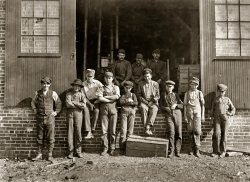
- Tifton: 1909
- ... work regularly. View full size. Photo and caption by Lewis Wickes Hine.
Tifton: 1909 This is Joe Manning of the Lewis Hine Project. ... Posted by Dave - 12/10/2007 - 3:20pm -
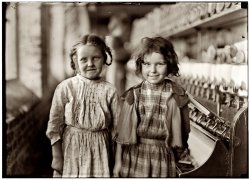
- We're No. 66!
- ... favorite Shorpy comment: T. Terrace's caption, a la Lewis Wickes Hine, of the decolorization of his own photo (I still laugh every ... Posted by Dave - 07/29/2009 - 10:44am -
![We're No. 66! Très excitement. Ken informs me that Shorpy is No. 66 on PC Magazine's list of the Top 100 Websites of 2009! (Yes, this is the kind of fluff incisive reportage magazines run in the summer so the staff can go on vacation, and we're happy to take part.) I want to thank tterrace, Stanton Square, Joe Manning and everyone else who has helped put us, if not on top, at least solidly in the top part of the bottom third! [UPDATE: Even though we are the 66th website on the list, Kyle at PC Mag tells us the results are not a numerical ranking but rather the results of voting on two groups: Top 50 "classic" sites and Top 50 "undiscovered."]
Yay Shorpy!There are millions of websites, but only one Shorpy. Being number 66 is quite an accomplishment.
66I log on to this site every day to see the new pictures that have been uploaded and I don't know why. I just find it fascinating to look at photos that are that old. a whole world that has come and gone before mine.
Apparently a lot of people feel the same way.
Great !!!!Congratulations from Brazil !!!
Congrats!Well deserved. This site is must reading/viewing for me!
CongratulationsCongratulations and well-deserved.
And, at 66, seems that you've just squeaked into the middle third!
Way to go, Shorpy!Should have been first, in my opinion.
Way To Go Dave!!!This is indeed a great thing for you and the readers/contributors here. A truly unique site that makes us all sit back, look and enjoy your version of the microscope to the past.
And I think I speak for all when I say a hearty 'thank you'.
Doug
Fluff or not,Fluff or not, congratulations are well deserved! This site is excellent, and should have been much higher placed.
Kudos all aroundGlad to have been along and look forward to moving onward and upward. Most Excellent! Figip for everyone!
Atta Boy Dave!!Just wanted to add my congratulations to the list.
Shorpy is my home page! First thing I see when I fire up Safari. Cheers!
Well doneI found you through James Lileks, word of blog so to speak.
Great News!You deserve it! One of my favorite sites!
Made Our DayWe should all be proud of Dave and Ken for creating, maintaining and constantly improving the Shorpy site. Those of us that are daily visitors and contributors celebrate with you.
Always Number ONE in my book!While this is great news, Dave, Shorpy is my favorite site to visit. A day doesn't go by where I don't check in to see what's new, or browse through older photographs. Your presence on Facebook is appreciated and hopefully is adding to Shorpy's traffic. I know that I keep promoting the site to all my friends, and will continue to do so.
Shorpy is Number ONE!
RankingsIt's a bit of a shock to see us 8 places behind Awkward Family Photos, but at least we beat out Ugliest Tattoos. Seriously, thank you, Dave! Happy to have done my part. Oh, and I also frequently put links to my contributions on my Facebook page for the benefit of my 38 Friends. That must have had something to do with it.
Unprepared remarksIn addition to my mother and my agent, I'd also like to thank all the nice people who nominated Shorpy for a spot on the list. In addition to the many commenters and photo posters whose contributions have made the site so interesting. And of course we can't forget the photographers whose work is shown here, and the archivists, technicians and historians who have helped make it available. And Ken (a.k.a. User1), who put both the dot and the com in Shorpy.com. And last but not least let us direct a round of applause to Shorpy himself. Clapclapclap!
Best of all......You guys did it without gratuitous sex, violence, vulgarity, or government subsidies. Good taste and quality every day on Shorpy!
Congrats!!
Doug
[Aside from the zillions in taxpayer dollars that made these photos available through the Library of Congress, and the occasional soggy wool bathing suit, this is all very true! - Dave]
So funny!>>>upper part of the lower third](https://www.shorpy.com/files/images/top100.thumbnail.gif)
- Tipple Boy: 1908
- ... Otha Porter Martin, born July 3, 1897." Photograph by Lewis Wickes Hine. View full size.
Shorpy II He resembles our Shorpy...there is ... Posted by Dave - 06/09/2018 - 3:45pm -
![Tipple Boy: 1908 UPDATE: The historian Joe Manning has more on the life of Otha Porter Martin here.
October 1908. "Tipple boy at the Turkey Knob coal mine in Macdonald, West Virginia." Says the LOC: "Patron identifies this as her grandfather, Otha Porter Martin, born July 3, 1897." Photograph by Lewis Wickes Hine. View full size.
Shorpy IIHe resembles our Shorpy...there is a genetic sameness to a lot of these boys in Appalachia from this era...my father said in WW II it was easy to pick out guys from central Appalachia...they all looked very much the same, in a time when people were not as mobile as now.
Tipple DefinitionWhat is a Tipple boy? I tried looking it up on line, but all definitions of tipple I could find had to do with alcohol.
[It's a boy who works in the tipple. - Dave]
Work UniformClose-fitting clothing was very important for a job like that.
From the photos, they must also have worn goggles at work.
[No goggles. - Dave]
What's on his head?What is on his head?
[A miner's headlamp (examples below). More information here. - Dave]
TippleTipple refers to the superstructure above ground that housed the draw works (hoist engine, cable drum, gear head etc) and the conveyor that took the ore away when the ore cart was tipped when it reached the surface.
Tipple BoyI'm not sure what you mean by genetic sameness. Inter-breeding? Let's break out the 'ole genetic charts from WWII Germany and compare notes. I believe all the Jews during that time were also subjects of genetic sameness. Re: the mobility theory. Why do the indigenous Peruvians resemble the Indians on the islands of San Blas? I would think mobility would be a bigger issue for these two groups but they must be inter-breeding because they have the same features. I think the people from NYC are inter-bred because they sound alike. What a silly conclusion. The miners of Central Appalachia came from many ethnic backgrounds during this time.
[It's a typo. He meant "generic," not genetic. - Dave]
Miners lampThe lamp is a carbide lamp. One used solid carbide in the lamp body and added water to it and lit the carbide gas that it produced.
SadThis picture makes me incredibly sad! I want to give him a big hug. He looks old beyond his time. He reminds me of Shorpy! These boys reslly never had a childhood. What a waste! Hopefully they grew strong and had a happier life later~
Otha Porter MartinThis is another photograph I recognized from my time spent on the LOC website. Another visitor identifies him as her grandfather Otha Porter Martin, born July 3, 1897. So nice when you can put a name to a face!
[Thanks! I've added that to the caption. - Dave]
Rock StarI recognize this from a wildly different source. Celtic rock fans will know this picture as the cover of the Seven Nations album "The Factory."
Open lights in a coal mine?Yuck!
And considering that safety mine lamps have been invented almost 100 years before the time of that photo, even a couple of competing designs within a few years, making those people work with crap like that was not just callous, but criminal.
By the way, electric isn't all that popular in coal mines if it's not batteries. An ex colleague of mine who had been a mechanic in a mine, told me that stationary lights there were run on pressurized air. Air turns turbine, turbine turns generator, generator runs light. All in a noisy, compact, gasproof, sparkproof package. Ventilation free of charge.
Bankers & MinersThe Tipple Boy and the additional images supplied in the comments took me back 30 years when I was a teenager working as a teller in a northern Indiana bank. The first time I saw a government check from the Black Lung Disability Trust Fund, it was an eye-opener. I had previously assigned black lung disease to a bygone era, and furthermore didn't feel a geographic or economic connection to the working conditions in the mining industry. It was one of those moments for me, as a naive kid, when I started thinking about the big picture.
To think Shorpy could have beenTippleBoy.com
First photo I thought ofUntil I found Shorpy, the first photo I thought of when I heard a reference to child labor laws was this one. I'm glad to know that this boy at least lived long enough to have a family.
So many of those boys photographed during this period were of an age where they might have served in WWI (like Shorpy did). I'd be willing to bet that those young men tended to complain much less about the drills, the facilities, the food, etc., than those who grew up more privileged. I'll bet even those who made it to the trenches in France complained less. Those boys in the coal mines even saw death, regularly.
Story of Tipple BoyThis is Joe Manning, of the Lewis Hine Project. I just completed my story about this boy, Otha Porter Martin. I interviewed some of his grandchildren. It's quite a story. He lived to be 87 years old. You can find the story at this link:
https://morningsonmaplestreet.com/2018/01/22/otha-porter-martin-macdonal...
(The Gallery, Bizarre, Kids, Lewis Hine, Mining)](https://www.shorpy.com/files/images/05361u1_1.thumbnail.jpg)
- Dinner Time: 1909
- ... Georgia." Last glimpsed here . Joe Manning of the Lewis Hine Project, who has spent five years unraveling the Young family's ... story here in fascinating detail. Photograph by Lewis Wickes Hine. View full size.
Shorpy and Joe Manning From when I ... Posted by Dave - 10/15/2011 - 5:02am -
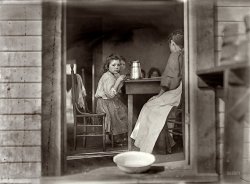
- The Lineup: 1911
- ... Street, No. 1 mill room. View full size. Photograph by Lewis Wickes Hine.
Very old children This is one of many of the Lewis Wickes ... Posted by Dave - 04/29/2008 - 12:09pm -
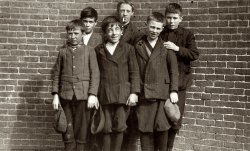
- Jeff Miller: 1913
- ... sent there." View full size. Photograph and caption by Lewis Wickes Hine.
At first I didn't understand At first I didn't ... Posted by Dave - 08/13/2013 - 4:11pm -
![Jeff Miller: 1913 October 1913. Houston, Texas. "Jeff Miller. A young delivery boy for Magnolia Pharmacy. This is especially bad for him as he has recently returned from the Seabrook Reform School where he had spent a year. He would not tell me why he was sent there." View full size. Photograph and caption by Lewis Wickes Hine.
At first I didn't understandAt first I didn't understand "especially bad for him" and then I realized, he was having to be out in public and see everyone who knew he'd been sent to reform school. I hope he got his life turned around. He and that bike are both too thin.
[Hine's point is that it's especially bad for a kid like this to be hanging out on the streets instead of getting an education. - Dave]
95 years later...http://www.magnoliapharmacy.com/
Jeff MillerAlso, it appears from previous photos that these boys made regular deliveries to parts of town young people should have had no business going to. Especially bad for a young man who has already been in trouble.
Jeff MillerThis is Joe Manning, of the Lewis Hine Project. I wasn't sure I'd find anything, given such a common name, but I did some research for about an hour today, and I am almost certain I've found Jeff. His name was James Jefferson Miller. He was born in 1899, and died in 1980, in Houston. He became a fireman. He was married and had children. I have requested his obituary from the Houston Public Library, and as soon as I get it, I'll be able to track down his survivors to see if I have the right guy. I'll let you know what happens.
Jeff Miller: 1913This is Joe Manning, of the Lewis Hine Project. I have posted my story about this boy. I interviewed his granddaughter. Jeff was quite a colorful character, and had an interesting, if difficult childhood. You can see his story, along with several photos of him with his wife and family, at:
http://morningsonmaplestreet.com/2014/11/26/jeff-miller-page-one/
(The Gallery, Bicycles, Kids, Lewis Hine)](https://www.shorpy.com/files/images/03891u.thumbnail.jpg)
- Smart's Bog: 1911
- ... 9 years old." View full size. Photo and caption by Lewis Wickes Hine.
cranberry pickers We lose sight of the fact that before ... Posted by Dave - 09/08/2011 - 7:12pm -
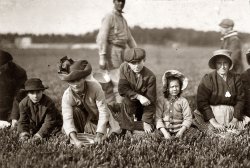
- Sunset School: 1921
- ... Pocahontas County." View full size. Photograph by Lewis Wickes Hine.
I wonder if the bottles I wonder if the bottles contain preserved ... Posted by Dave - 09/11/2011 - 7:23pm -
![Sunset School: 1921 October 7, 1921. "School in Session. Sunset School, Marey, West Virginia. Pocahontas County." View full size. Photograph by Lewis Wickes Hine.
I wonder if the bottlesI wonder if the bottles contain preserved frogs or similar for dissection? It reminds me of an old one I had once, and would perhaps explain the variety of queasy and mischievous expressions.
That vial is a temptationA fantastic photo. The flowers on the teacher's desk are touching. I like the pail next to the water jug in the back. I do hope the teacher didn't swallow what was in that vial she's contemplating so earnestly.
Boys will be boysMy new favorite photo. Everyone is posing stiffly in their Sunday go-to-meeting clothes except the rascal on the left. But why are their eyes closed?
It's the waterDid someone dump arsenic in the well? Most of these kids look like they came out of "Night of the Living Dead".
Avenging Angel?Great pic - some barefoot students, tatty shades, but a jar overflowing with fresh flowers! - is that a picture of an angel with a sword on the side wall? Also, any clue as to what the cylinders are that the teacher is using (appears to be a set in a special case)?
Wireless SchoolhoueNo sign anywhere of the schoolhouse having electricity. Dark window shades are drawn also. Yet there seems to have been a good source of light somewhere in this classroom.
Living DeadI'm with you on that one - it reminds me of "memorial photographs" from the Victorian era.
One Room SchoolhouseMy mom was taught in a similar class of various ages and said that the teacher took each age group while the others worked on something else. I see the older looking kids in the back on the right are reading, while she appears to be explaining something to this somewhat younger group while showing them something in a bottle, taken from a kit of similar items. Are they paints? Can you see what is in her hand? Oh, if only we had a real time machine, huh? There must have been a well outside as seen by the bucket inverted next to the crockery water vessel. Either one of the big boys or the teacher would have to bring in water each day. Be glad we have shoes for our kids in October, since it isn't really summer. A beautiful and thoughtful photo of the "roaring twenties" when NOT all of America was prospering. West Virginia's employed people at the time were probably coal miners and not everybody was dancing and partying.
Poverty?When this picture was taken my mother was 8 yrs old and sitting in a school house no doubt just like this within 40 miles of where this picture was taken(Elmira, WV). From the stories of my Mom and Dad we can not imagine the poverty. Most kids got one pair of shoes a year and had to make them last (and hand them down). The teacher is probably 18 or 19 at most. There would have been an outhouse and probably an outside pump. If lucky kids might have gone to 8th grade but most (especially boys) stopped at 4 to 6th grade. Many of these kids grew up to move north to Ohio and Michigan. They used to say WV schools taught the 3-R's = readin, 'rightin, and Rt 21 (the route to Akron and the Rubber factories). Others went to Detroit and built the cars to put the tires on.
The poverty was great but most of them didn't realize it. I once asked my Dad what the Depression was like and he said none of them ever noticed it since they were always poor. They had no cash and traded milk and eggs for what ever they couldn't grow or hunt on their own. Dresses were sown from flour sacks. He said that he and Mom rented an 80 acre farm for $40/yr when they were first married and never managed to make the payment. But they raised three kids, 8 grandkids, owned their own homes and cars. These kids had no idea how far (literally and figuratively) most of them would go in the next 60-70 years.
WV (and especially this part of it) was very poor and very isolated. Most at this point had never seen a car much less ridden in one. No imagination of electric lights, telephones, air-conditioning, TV. Some might had heard a radio but probably didn't own one. Travel was by horse and wagon at best.
So don't look at the poverty --- look at this as the starting point of a great adventure. I can not imagine my life progressing as far and as differently as the lives of my parents and this generation.
My Great-Great Grandfather.......taught at the Milhoan Ridge School in Jackson County West Virginia. I have a great old picture of him with his hunting dogs. His name was William Tack Milhoan. Don't know why the Archivist would want to ruin the shot of the school by putting a title over it.
BTW, what is the Winged Victory figure in the poster near the window wearing?
WV schoolNo wonder these kids ended up in the mines, with a dour looking teacher like that. what a depressing look at their lives. I hope some of these children rose above their poverty.
Questions: Do you think thatQuestions: Do you think that they knew that a photograph was being taken that day? The young, unmarried teacher is nicely dressed and has flowers on her desk, along with two bells and a pencil sharpener. A few of the students are dressed up too--love the little girl with the huge bow in her hair. However, it's October 7th and two kids are, of necessity, barefoot, The girl is crossing her feet almost in a hiding manner. Please tell me that they had outhouses and not just the overturned bucket in the back of the room. What do you suppose the teacher is holding in her hand?
No shoesI had heard people from that era saying they hadn't had shoes until they were 18. Kinda rough to see it on these kids.
Creepy, retouched eyes?What a great photo.
That classroom must have been dark in that classroom when the flash powder ignited as it appears that most of the students blinked, only to have their eyes applied to their eyelids in post production. This detail gives the photo an unsettling quality.
["Post-production"? You've been watching too many movies. The eyes look the way they do because the camera shutter is open longer than the duration of the flash. So you get open eyes superimposed with closed eyelids (when the flash makes everyone blink) in the same shot. - Dave]
Praying?Looks like it is prayer time or they are trying to visualize something. We could learn a lot by going back to some of these old ways... The new ones don't seem to be working too well...
Bare feetWest Virginia was very poor then so the bare foot kids probably had parents that couldn't afford shoes. They were just lucky to be able to even go to school.
Fancy BootsCheck out the boots on the child hidden by the flowers. His dad must have been the town millionaire.
Quite the contrast with Shoeless Joe and Shoeless Jill to his immediate right. By October 7, it was getting a wee bit chilly in that area. Just about time to start lighting up the big stove just behind Mr. Fancy Boots.
Old photographyOh, that effect of seeing the eyes and the closed eyelids is so creepy.
Winged VictoryA reply to ne_time_now:
The poster appears to be an old war stamps poster probably from WWI.
Population figuresOn a hunch I looked up the population of the county in Vital Stats. 1920 was the peak for population in Pocahontas County, WV with around 15,000, up a thousand or so from 1910 and again for 1900. Population declined to about half of that and was 9,000 in the 2000 census.
We are viewing the county at the peak! And I lived in WV in the mid, late 60s.
Funny how migration and whatever external factors will have on population. We always think more and more people are coming in and in this case, it is not. In my home county in Kentucky, the population was in the 15,000 range in 1840 and it took until the 1950 or 60 census to get back to that level. Now, we're overrun with people around here!
AppalachiaLarry K's comments sum up all the other comments so well. I grew up in Appalachia -- southeastern Ohio -- and my 75-year-old parents still live there, three miles from Route 21. Though my five brothers and I were far from rich, we certainly had it better than our parents, who were both born in the middle of the Great Depression. Mom's parents also rented a farm and her father worked in a coal mine to support the family of twelve. Mom told us bedtime stories about her childhood -- "undies" made of flour sacks that were stamped with "Pillsbury's Best," etc. I could detect no bitterness in her voice, only fondness and perhaps a little remorse for the loss of "the good old days."
Better or Worse?Pocahontas County was actually booming in those days--far better off than it is today--with lumber being the main industry. Granted, the people weren't very well off, but most were working and for the most part this area was typical of rural America at the time. Shoeless kids weren't an uncommon sight anywhere back then when weather permitted.
Angel AngleNotice the picture on the back wall with the little girl. On one side the "good" angel urging her to do right while the "bad" or "dark" angel urges her to misbehave. I know I heard that lesson a few times in my youth.
I love the comments on this one........probably as much, or more, than the actual photograph. My grandmother taught elementary school in the '20s in a farming town in California. Her stories remind me a lot of this photograph. The one thing she always emphasized was how much fun they had. Apparently, she and a couple of other teachers were known for their pranks. Thanks to everyone for their interesting and thoughtful comments!
Mystery deviceWhat is that next to the Water jug? A book stand? Someone's crutch? A music stand?
Some Had No ShoesMy dad often told me he and his brothers had no shoes. They had to walk on the railroad tracks, barefoot, to get to school. They lived in a log cabin with no floors. During the winter, their father dug a big hole in the ground and they slept in it to escape the cold wind blowing in through the cabin walls.
Haves from Have-NotsIt's very easy to pick out the haves from the have-nots.
(The Gallery, Education, Schools, Kids, Lewis Hine)](https://www.shorpy.com/files/images/04354u1.thumbnail.jpg)
- Bibb Mill Girls: 1909
- ... adolescents in Bibb Mill No. 1." Photograph and caption by Lewis Wickes Hine. View full size.
Brown Lung All the mill workers we've ... Posted by Dave - 02/13/2008 - 4:14am -
![Bibb Mill Girls: 1909 January 19, 1909. Macon, Georgia. "Some adolescents in Bibb Mill No. 1." Photograph and caption by Lewis Wickes Hine. View full size.
Brown LungAll the mill workers we've seen have an alarming amount of lint and fiber on their clothes, in their hair--you know they must have inhaled so much.
I wonder what they would look like if they had the lives of the DC basketball girls, below.
Macon, GeorgiaI live in Macon and if I am not mistaken this building still remains today, and is a great antique store. Boy don't we know how to raise those Southern belles here?
That GirlIs it my imagination or does the angry looking one in the center look "not all there"?
Yep!She does have that "Full Metal Jacket" sort of look in her eye, doesn't she?
Angry girlThey all look tired and unhappy. It would be interesting to know what was happening right before the picture was taken.
Why tired and unhappy?I would surmise it was long long hours that would not even be allowed for adults, let alone children, in this day.
Tired and unhappyTired and unhappy is easy enough to understand given the photo was likely taken to document unpleasant work conditions, but the girl in the middle not only looks 'not all there', but as if she were about ready to punch Hine and her friend wants to calm her down or hold her back with that hand on the shoulder. Wonder if she was a bit 'odd' and prone to fits of temper, or just PMSing and didn't want her photo taken after a long, sweaty day's work.
Bibb Mill GirlsWow, the turn of the century child worker photos always get me, but this one in particular breaks my heart. They look so weary, so old before their time. I hope they found some rest and happiness later on in life.
Bibb MillI thought the Bibb mill was in Columbus, Ga. Was there more than one? The bits extant in Columbus are lovely.
[Bibb Manufacturing, one of the largest employers in the South in the first half of the 20th century, got its start in Macon. Eventually it had over a dozen mills. - Dave]
PostureA big reason the girl in the middle looks "angry" or "not all there" is her posture: forward head and shoulders, maybe mild torticolis, one shoulder higher than the other. The kid probably had scoliosis and or congenital torticolis, neither condition which would have been helped by leaning over mill machinery all day.
(The Gallery, Kids, Lewis Hine)](https://www.shorpy.com/files/images/05401u1.thumbnail.jpg)
- Shorpy at Work: 1910
- ... as far as we can tell, the first of only four photographs Lewis Wickes Hine took of Shorpy on his visit to the Bessie Mine late in 1910. (The ... Posted by Dave - 05/08/2019 - 4:29pm -
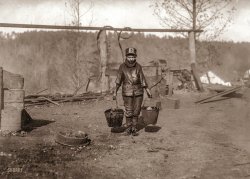
- Oysterboy: 1909
- ... is here six months a year." Glass negative and caption by Lewis Wickes Hine. View full size.
His Left Foot I wonder what happened to ... Posted by Dave - 08/03/2012 - 3:04pm -
![Oysterboy: 1909 January 1909. Apalachicola, Florida. "A young oyster fisher. Randsey Summerford says he starts out at 4 a.m. one day, is out all night in the little oyster boat and back next day some time. Gets a share of the proceeds. Said he was 16 years old and been at it four years. Lives in Georgia and is here six months a year." Glass negative and caption by Lewis Wickes Hine. View full size.
His Left FootI wonder what happened to his other shoe.
Oyster BoyJoe Manning, from the Lewis Hine Project. This young man died in 1971. I have requested his obit, and I have the address of one of his relatives. I'll let you know what happens.
Randsey Summerford...seems to be listed in the 1910 U.S. Census as Lounzo Summerford / Semmerfort, home Apalachicola, Franklin, Florida, occupation oysterman, age 18 born about 1892 in Georgia, father born in Louisiana but not listed, mother Margaret, 56, born in Georgia, one sister, Gena, same age and birthplace.
Photoshop footWhy doesn't his left foot cast a shadow like his right?
[It does. - Dave]
Smells FishyWhy is this kid the only white person in the frame? In this part of the country, (where I currently live) oystering was usually a family enterprise and it is very odd that a Negro crew would have a white employee (although, not vice-versa). I hope we find out more of backstory because I suspect, the census not withstanding, that Hines [sic] was either mislead [sic] or artfully arranged these people to fit his crusade against child labor.
[Hine's caption notation from a different oystering photo: "Mostly negro workers. The boss said, 'We keep only enough whites so we can control the negroes and keep them a-going!' " Below: Another mostly black Apalachicola oyster crew from January 1909. - Dave]
Oyster TongsOne thing I can tell you about oyster tonging is it takes a real man to do it all day. When I lived on the Chesapeake Bay in the 60's and 70's I had the opportunity to try my hand at using oyster tongs to harvest oysters....it ain't easy!!! The heavy tongs hinge about where his right hand is and when dropped straight down to the bottom the jaws open about one foot for a spread at the surface of about four feet. After closing the jaws to scrape oysters from the bed the rig is hauled back up and opened to release the oysters on deck. For pussies like you and I it is hard just to do it a few times much less all day. Oystermen have fantastic arm and chest muscles and one thing for sure, don't ever get in a brawl with them...they are as tough as they come. When I went out with friends who were from oystering families they had quite a good-natured laugh at my pathetic attempts to oyster, though I worked out and was fairly active....after a few trips to the bottom and back I was pooped. So think about that when you look at these guys in the picture who had arguably one of the toughest jobs ever. "Oyster Boy" indeed!
OysterboyThis is Joe Manning, of the Lewis Hine Project. You can see my story of this boy at this link:
http://morningsonmaplestreet.com/2015/01/18/ramsey-summerford/
Tough OystermenTo further Anonymous Tipster's point from 2008, the young men who worked the oyster boats in Apalachicola, Florida, were indeed tough. I lived in that wonderful town for about five years in the mid-1960s and Chapman High's football team was consistently much better than others in their class. Considering how small that school was, it was remarkable.
I always chalked that up to the work many of those young men did on oyster boats. Their upper-body strength was uncanny.
--Jim
(The Gallery, Boats & Bridges, Florida, Kids, Lewis Hine)](https://www.shorpy.com/files/images/05407u.thumbnail.jpg)
- Donnie Cole: 1910
- ... posted in the mill." Photograph and caption by Lewis Wickes Hine. View full size.
Young Granddad My grandfather was born ... Posted by Dave - 07/24/2012 - 7:14pm -
![Donnie Cole: 1910 November 1910. Birmingham, Alabama. "Donnie Cole. 'Our baby doffer,' they called him. This is one of the machines he has been working at for some months at the Avondale Mills. Said, after hesitation, 'I'm 12,' and another small boy added, 'He can't work unless he's twelve.' Child labor regulations conspicuously posted in the mill." Photograph and caption by Lewis Wickes Hine. View full size.
Young GranddadMy grandfather was born in 1910. When he was 12 his dad made him get a job and then quit working, so my grandfather had to support his family. When I was little and would complain about not getting a toy or something equally unimportant he would bristle and scold me for not appreciating what I had. He died before I was old enough to realize what he was talking about. Now I look back on him with my adult eyes, and wish I could tell him I now understand. People that grew up like this grew up hard.
ImpactPretty powerful photo. Pretty sad.
This poor lad has evidently lost his left arm and right hand to this machine. Apparently this was not an uncommon fate of doffers.
[Donnie's arms and extremities are all intact. Loss of a limb in the mills would definitely have been an uncommon fate. - Dave]
Strong resemblanceThis little fella bears a strong resemblance to my four year old son. How lucky we are, indeed. I'm going to give him twelve extra hugs today - and give one in my heart to little Donnie Cole by proxy. Bless his heart.
Donnie Cole: 1910Donnie Cole
My name is Donnie Cole.
I work here every day.
I think I'm 12 years old,
That's what my my momma say.
Sometimes I’m a doffer,
Sometimes I sweep the floor.
I used to go to school,
But I don’t do that more.
From the song “Donnie Cole.”
by Joe Manning, ©2009
Lewis Hine Project
Donnie Cole: Baby DofferThis is Joe Manning of the Lewis Hine Project. I was able to determine that this boy was named Lonnie, not Donnie. With that information, I tracked down his obit, but he left no children. But he did leave a sister, and I found her obit, which led me to Dorothy, one of her daughters. I sent the picture to her and called her today. She was so thrilled to get the picture of her Uncle Lonnie that she invited a bunch of her family members over to see it. I will be interviewing her soon. She told me that little Lonnie was short, and as an adult, looked pretty much like he did in the picture. She said he was always wearing a railroad hat.
Donnie Cole, Baby Doffer: 1910This is Joe Manning, of the Lewis Hine Project. I interviewed a niece of Lonnie (not Donnie) Cole. She called him Uncle Lon, or just Lon. She spoke very highly of him. You can see my story of Lonnie at:
http://morningsonmaplestreet.com/2014/12/29/lonnie-cole/
(The Gallery, Birmingham, Kids, Lewis Hine)](https://www.shorpy.com/files/images/05463u.thumbnail.jpg)
- Rosina Goyette: 1911
- ... to three weeks. Her partner said 'a few weeks.' " Photo by Lewis Wickes Hine. View full size.
Rosina Goyette: 1911 This is Joe ... Posted by Dave - 04/08/2009 - 7:24pm -
![Rosina Goyette: 1911 September 1911. Winchendon, Mass. "Rosina Goyette, Maple Street. Apparently 12 but says she is 14; has steady job doffing and spinning in Spring Village Mill. Said at first she had been working six months, later she changed it to three weeks. Her partner said 'a few weeks.' " Photo by Lewis Wickes Hine. View full size.
Rosina Goyette: 1911This is Joe Manning, of the Lewis Hine Project. Rosina lived into her 90s. I recently interviewed her granddaughter. Hine took 40 photos in Winchendon in September of 1911. I have been researching all of them for the past six months. You can see a lot of what I have found on my website at www.morningsonmaplestreet.com/winchendon.html
Sad portraitShe looks like she is from the dead zone, not a pleasant childhood.
SPLASH!Toto, I don't think were in Kansas anymore. Toto?...Toto???
What does "partner" mean?What does "partner" mean? Is this girl married at her young age?
[It's a girl who works with her at the mill. - Dave]
It's Wednesday...... of the Addams Family. Her full name was Wednesday Friday Addams.
Rosina Goyette: 1911This is Joe Manning, of the Lewis Hine Project. I interviewed the granddaughter and daughter-in-law of Rosina. They live near me and visited my house. They had some terrific photos of her. Rosina lived to be 98 years old and was quite a colorful lady. You can see the whole story on my website.
http://morningsonmaplestreet.com/2014/11/26/rosina-goyette-page-one/
(The Gallery, Kids, Lewis Hine)](https://www.shorpy.com/files/images/02301u.thumbnail.jpg)
- Sea Urchin: 1909
- ... boats in the harbor during school hours." Photgraph by Lewis Wickes Hine. View full size.
Poor kid! He never knew the joys of ... Posted by Dave - 08/05/2012 - 6:21pm -
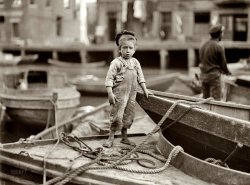
- Shut This Door That Means You
- ... 1908. View full size. Photograph and caption by Lewis Wickes Hine.
One trapper's description of the job, which paid about $1.60 a ... Posted by Dave - 01/08/2009 - 11:24am -
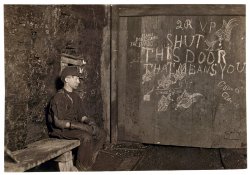
- Cribs: 1913
- ... boy making delivery to 'crib' in Red Light." Photo by Lewis Wickes Hine. View full size.
Call Me Madam Love her mobcap -- soooo ... Posted by Dave - 04/08/2010 - 11:05pm -
![Cribs: 1913 October 1913. San Antonio, Texas. "Sixteen-year-old messenger boy making delivery to 'crib' in Red Light." Photo by Lewis Wickes Hine. View full size.
Call Me MadamLove her mobcap -- soooo sexy.
The package in his pantsIs tucked into the waistband. Most of these messengers who frequented the "Red Light" were making deliveries from pharmacies to the working girls -- probably patent medicines containing cocaine or heroin, along with prophylactics. This boy is shown in another Hine photo entering a "crib."
Good for herYou might have expected here, especially from Lewis Hine, a man for whom the camera was usually a weapon in a moral crusade, that the woman would be at least a little ashamed of being photographed like this: in flagrante, as it were. But look at her! She couldn't care less. That's such a wonderfully bold, amused, shameless look.
How do you knowHow do you know what this photo is about? I looks like anywhere 1900 USA.
[How do we know what any of these photos are about? Because the photographers captioned them. - Dave]
HineophileI am a big fan of Lewis Hine and his documentary photographs. I really enjoy the snapshot quality he adds to the composition of his images. And the print quality is always great. He always manages to capture such a great moment on the faces of his subjects. Whether he manipulated and directed them or not, I don't think it matters. They still come across as natural and that is the important part.
(The Gallery, Lewis Hine)](https://www.shorpy.com/files/images/05527u.thumbnail.jpg)
- Popeye and Friends: 1911
- ... Massachusetts. Works in Eclipse Mills." Photograph by Lewis Wickes Hine. View full size.
love the photos, something love the photos, ... Posted by Dave - 09/07/2011 - 5:14pm -
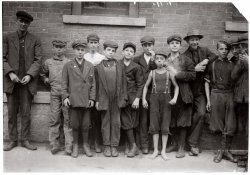
- Three Weeks at It: 1912
- ... but the mill wanted me." View full size. Photo by Lewis Wickes Hine.
Long-Ago Childhood When I see the faces of these children, ... Posted by Dave - 05/02/2008 - 7:55pm -
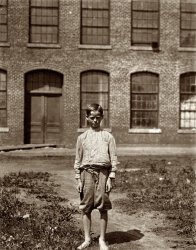
- Nipper Joe: 1911
- ... 163 Pine St." View full size. Photo and caption by Lewis Wickes Hine.
Nipper Joe This is Joe Manning, from the Lewis Hine ... Posted by Dave - 09/08/2011 - 6:20pm -
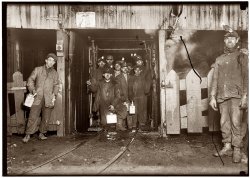
- Skeeter's Branch: 1910
- ... visit with this memorable group. Photo and caption by Lewis Wickes Hine. View full size.
Dickens anyone? They look like a bunch ... Posted by Dave - 07/18/2011 - 10:46am -
![Skeeter's Branch: 1910 St. Louis, Missouri. "11 a.m. Monday May 9, 1910. Newsies at Skeeter's Branch, Jefferson near Franklin. They were all smoking." Our third visit with this memorable group. Photo and caption by Lewis Wickes Hine. View full size.
Dickens anyone?They look like a bunch of young pickpockets from a Charles Dickens novel.
But OllieLooks like a young Stan Laurel on the right. Can anyone read the headline?
ResemblancesActually, the guy on the right is a dead ringer for Joseph Gordon-Levitt. And the Bearded guy in the paper looks like George V, who came to the British throne that year.
Gotta be GeorgeEdward VII died three days earlier, so I imagine George V would be front-page news on the 9th.
Just be calmBet the kid on the far right was sent to buy a paper from these thugs; and not sure he will make it home.
[The guy on the right is probably Skeeter. "Branches" were paper drops. - Dave]
That's itThat's it. I'm canceling my son's paper route.
What does sign mean?I see the sign sticking out from the storefront says "St. Louis Times - Just White, and Read"
What does that mean, that it's not yellow journalism?
[The sign says "St. Louis Times tells the truth: Not yellow, just white and read." Something like the old riddle "what's black and white, and read all over." So yes, it means it's not yellow journalism. - Dave]
Well behaved schoolchildrenThe children sitting in St. Louis classrooms were all well behaved because those that weren't, well, they were out smoking and selling papers.
Every one of them looks to be 12 going on 50.
I wonder, if this photo was published in the St. Louis Post Dispatch today, would anybody recognize a relative?
The Fagan of Skeeters Branch...I'm with Lord-Velveeta--Dickensian, indeed! My very first thought was, "Oh, that must be their version of Fagan over there on the right!"
A little older, a little aloof, a LOT more wicked...and standing just far enough away to claim he wasn't involved in any of the other boys' mischief.
[He would seem to be the Skeeter of Skeeter's Branch. - Dave]
That's not Fagin...It's the Artful Codger.
SmokingBack in 1956, when I was about the same age as these guys, I took up smoking, along with some friends. Not very long after that I was smoking three packs a day. In 2003 I quit cold turkey -- not at all easy. I wonder how many of the kids in this picture were hooked for decades or never did quit.
Successful newsieIn the foreword to his account of WWII experiences, James M. Gavin wrote:
"I had just passed my tenth birthday when the United States entered World War I. I was living in Mount Carmel, Pennsylvania, where I sold morning and evening newspapers. My favorite corner was at Third and Oak Streets, which was the Main intersection of our small town." (On to Berlin)
This newsie, who may have looked just like these boys, was born in 1907, placed in a Brooklyn orphanage at age 2, adopted at 9 by a coal miner and his wife, had a hard childhood, and left home at 17 to join the army where he applied himself and graduated from West Point. He became the wartime Commanding General of the 82nd Airborne Division, retired as a lieutenant general, and became Ambassador to France, plus a career in business.
Skeeter's BranchThis is Joe Manning, of the Lewis Hine Project. Earlier this year, I got the St. Louis Post-Dispatch to publish this photo and an article about my project. I got a call from a man who claims he was distantly related to several of the boys, who were brothers. He gave me their names and even sent me a photo of one of the boys when he was 19 years old. He looked just like him. The man said he knew very little other information, but he gave me the name and phone number of that boy's granddaughter. I called her, and she said that she didn't think the boys were related to her, and she didn't want to talk about it. I am convinced that the man was correct, and that the granddaughter just didn't want the publicity. Too bad.
You're RightWhen I did my route in Rotterdam, hell, I smoked like a oceanliner!!!
Skeeter's BranchThis is Joe Manning, of the Lewis Hine Project. The second boy from the left was Raymond Klose. His niece identified him. See my story about him at:
http://morningsonmaplestreet.com/2015/01/01/raymond-klose/
(The Gallery, Kids, Lewis Hine, St. Louis)](https://www.shorpy.com/files/images/03486u1_0.thumbnail.jpg)
- John Slebzak: 1909
- ... Island, Louisiana. View full size. Photograph by Lewis Wickes Hine.
SSDI Results John Slebzak
b. 17 Feb 1898
d. Sep ... Posted by Dave - 08/26/2011 - 3:22pm -
![John Slebzak: 1909 John Slebzak, working on the Bottomley farm near Baltimore with his family (Polish). They have worked here three years and one winter at Avery Island, Louisiana. View full size. Photograph by Lewis Wickes Hine.
SSDI ResultsJohn Slebzak
b. 17 Feb 1898
d. Sep 1971 Halethorpe, Baltimore, MD
[Shorpy is impressed! Thanks, Emo. - Dave]
dot comI'm going to go register slebzak.com and give shorpy.com some competition! See you on the internets!
John Slebzak: 1909This is Joe Manning, of the Lewis Hine Project. I just talked to one of John's sons. He didn't know about the photo. There are three Hine photos of the Slebzak family on the Library of Congress website. I will be interviewing the son in a couple of weeks.
John Slebzak: Berry Picker, 1909This is Joe Manning, of the Lewis Hine Project. I have completed my story on this little berry picker. See it at
http://morningsonmaplestreet.com/2014/11/26/john-slebzak-page-one/
(The Gallery, Baltimore, Kids, Lewis Hine)](https://www.shorpy.com/files/images/00012u.thumbnail.jpg)
- Boys With Brooms: 1908
- ... Sweepers in a North Carolina cotton mill." Photograph by Lewis Wickes Hine for the National Child Labor Committee. View full size.
... Posted by Dave - 08/15/2012 - 9:50am -
![Boys With Brooms: 1908 November 1908. "Some Sweepers in a North Carolina cotton mill." Photograph by Lewis Wickes Hine for the National Child Labor Committee. View full size.
DistractionsLewis Hine must have had an assistant with him for all his group shots -- there are always a few people looking to the photographer's right (especially the women in groups). Having started out as an assistant "holding the light," I had to keep quiet so as not to attract someone's eyes!
[Or it might have been Hine himself. - Dave]
(The Gallery, Factories, Lewis Hine)](https://www.shorpy.com/files/images/01400u.thumbnail.jpg)
- Don't Smoke, Visits Saloons: 1910
- ... saloons. Works 7 hours per day." Photograph and caption by Lewis Wickes Hine. View full size.
_ _ _ _ OD _ _ _ LS Goodwills?
[A ... Posted by Dave - 07/24/2012 - 7:06pm -
![Don't Smoke, Visits Saloons: 1910 May 1910. Wilmington, Delaware. "James Lequlla, newsboy, age 12. Selling newspapers 3 years. Average earnings 50 cents per week. Selling newspapers own choice. Earnings not needed at home. Don't smoke. Visits saloons. Works 7 hours per day." Photograph and caption by Lewis Wickes Hine. View full size.
_ _ _ _ OD _ _ _ LSGoodwills?
[A store selling "goodwills"? We can see the start of the letter after the D. It begins with a vertical that doesn't go across (i.e. not E, L, etc.). That leaves F, H, I, K, M, N, or R. - Dave]
The answer is ...PERIODICALS & NOVELTIES
_ _ _ _ OD _ _ _ LS & NOVELTIESWheel of Fortune, anyone? Vanna!
Loose leaf systems, and then someI'd love to shop in that store behind him. I can see ledger books, file folders, picture postcards, drafting triangles and an ad for Koh-i-Noor pencils in that window display. It's funny how they've put all that Waldorf toilet paper up in the top windows, too.
[Let's hope the TP isn't loose-leaf. - Dave]
Big shop windowsDoes it surprise anyone else that they were able to make such large plate-glass shop windows a century ago?
Rubber stampsIt may be that the round objects in the windows are Waldorf Tobacco. At any rate there was a Waldorf Tobacco Company in Germany in the late 19th Century and on into the 20th. Oddly, the Waldorf system of childhood education that was practiced by its employees is still taught today. But what really interests me is that this store had a special sign advertising "rubber stamps". Now, that's something that some folks find useful!
[Seems to be TP. - Dave]
JamesI know average height is taller now, and poor kids with bad nutrition might be small, but that boy does not look 12 yrs old, even on the short side. Compared to the 'average" of the grownups in the pic, he looks more like 7. And small for that, even then.
Rubber Stampsdgorton: "But what really interests me is that this store had a special sign advertising "rubber stamps". Now, that's something that some folks find useful!"
Well, yes, rubber stamp shops and shops selling them were useful.
There was still one in downtown DC when I lived there in the early '90s. Perhaps it's Amity Rubber Stamp (1430 H St NW), that seems to still be around and it's in the vicinity I recall. Quite a niche market, I suppose.
This place was very vintage...dark, dusty, quiet...but they make nice custom stamps by hand (Ray was the guy who seemed to run it).
And they're not particularly cheap...compared to those quickie, cheapie self-inking ones at the chain office supply places.
Hmmm...next time I'm in DC, I should stop by and take some pix.
WilmingtonThanks for posting this, Dave. Wilmington is where I was born. Sadly, though, I am fairly certain I am related to no one in this picture. Until the 1990s, when I was in high school, there was a historic Woolworth's that might have been this building. I don't know what they've done with it in the past decade, though.
Little JimmyThe average male "grown-up" height was probably around 5 feet 5 inches at the time. Take a look at the rolls for those joining the services for the First World War. It's amazing how many men were 5-foot-2 at that time. Yes, that kid is tiny.
Rubber stamp shopsThey handle everything from rubber stamps to corporate seals to trophies to engraving. Rubber stamps are extensively used in law offices, and especially in the corporate and real estate departments.
They're far from obsolete: there are four rubber stamp shops within walking distance of my house.
Rubber Stamp ShopsThere are still rubber stamp shops. I'm sure almost everywhere you live if you look in the yellow pages you'll find a shop that makes stamps. I create logos for a living, and often e-mail artwork to places that make custom stamps. Where do you think the stamps come from that they stamp on your hand when you go to an event/concert?
Wilmington NewsboyThis is Joe Manning, of the Lewis Hine Project. I just found this boy's grandson. I talked to him and linked him to the photo, and he says it's his grandfather. His own father, the newsboy's son, is in his eighties. The family was not aware of the photo. More later.
[Amazing! (As usual.) Is his last name really Lequlla? - Dave]
Wilmington NewsboyHis name was not Lequlla, but it was pretty close. I'll have to hold back more information until I interview the family. Stay tuned.
Ledgers R UsAppears to be a stationery store, with paper, notebooks, writing instruments, ledgers, calendars and of course rubber stamps. Most have long become Office Max and the like.
I have seen some wizened kids on Shorpy, but this kid may take the cake. If you cut and pasted that face on an old man, it would work. No way he's 12, either. He looks like the old man in Prizzi's Honor, whose name escapes me.
James Logullo"He belonged to a veteran’s club right across from his cab company, and he’d go over there on amateur night. He loved the Ink Spots and the Mills Brothers and Al Jolson. He’d sing their old songs and people went crazy. He was very good at it. He was in his glory." -Tom Logullo, son of James Logullo (correct spelling of surname.)
This is Joe Manning, of the Lewis Hine Project. James was actually only seven years old when he was photographed. He was a colorful character, much loved by his son, whom I interviewed. See the story at:
http://morningsonmaplestreet.com/2014/11/26/james-logullo-page-one/
Dang right!I use rubber stamps every day. Ordered new ones not that long ago too. We had one that was 30 years old or so and had to be replaced. Rubber stamps are the best. Those new kind, which we use for faxes and stuff, wear out within a year or two of service.
Franklin Rubber StampIt's called Franklin Rubber Stamp and it's still on Franklin Street downtown. The window has all the original lettering still intact. I walked by it a few years ago and actually stopped to admire it and the architecture of the building.
Very StrangeThis 2008 post, last commented on in 2010 showed up today in the daily top 5 list on my browser when I logged in to Shorpy. I was born and raised in Wilmington, DE and the son of this fellow, interviewed by Joe Manning, was my Scout Master in the 60s.
The "vets club" mentioned in the interview would be Diamond State Post 2863, VFW of Delaware. I have sent links to this photo and Joe's site to a friend of mine there asking if there are any photos or other records of James' activities while a member there. I will let you all know if I hear any further news.
The strange thing is, just yesterday I was looking for Joe Manning's web address for a different project I am working on involving a vet I served in the Army with in 1971. It's truly a very small world.
(The Gallery, Kids, Lewis Hine, Stores & Markets)](https://www.shorpy.com/files/images/05324u1_0.thumbnail.jpg)
- Sagamore Mill Boys: 1911
- ... works in spinning room on third floor." Photograph by Lewis Wickes Hine. View full size.
Tough or serious? Nearly every photo of ... Posted by Dave - 06/27/2011 - 10:54pm -
![Sagamore Mill Boys: 1911 August 1911. Fall River, Mass. "Group containing the following boys who work in the Sagamore Manufacturing Co. Manuel Correira, 144 Cove Street, works in spinning room on top floor. Said, 'I only help mother.' He was apparently 13 or 14. Manuel Oliver, George Street, works in card room. Seems surely only 12 years old. Manuel Benevirdes, 30 Otto Street, works on top floor. Manuel Rage, 51 George Street, works in spinning room on fourth floor. John Oliver, 93 Slater Street, works in spinning room on third floor. Joseph Ariuda, 23 Shorr Street, works in spinning room on third floor." Photograph by Lewis Wickes Hine. View full size.
Tough or serious?Nearly every photo of this type from this era shows the boys doing their best to look serious or tough. You wonder if it had more to do with wanting to looking grown up or more about not letting their guard down.
Text-tilesIs the fellow at the far right texting his sweetheart that he is running late due to a photo shoot?
Facebook updateThe fellow on the right is obviously doing a status update on his iPhone or possibly checking his cash situation.
Some things never changeThat guy on the right is texting, right?
Mr tough-guy!Love the attitude of that the kid with the crossed arms. He may not be the oldest or biggest, but he must be one of the leaders, what with the attitude, and better clothes, he seems to be saying "these are my boys, so back off!"
Industrial RevolutionSeems like this mill needs to join the Industrial Revolution. Most of the work is being done by Manuel labor.
Fancy HandleOn that bumbershoot held by the young man third from the right!
A different kind of educationI know the child labor movement was a platform that had to be dealt with due to abuse, etc. However, these kids were getting a different kind of education, learning responsibility, what it took to earn money, following rules, how to cooperate and work with others, the ability to help their families improve. Perhaps they couldn't spell and/or read perfectly, etc. but neither were they out in the streets in gangs, planning drive-bys and home invasions. I notice these days when youngsters get in serious trouble, their elders say "they need someplace to go and something to do." The kids pictured here were helping, not hurting anyone. Yes, I am a cranky old curmudgeon, wanna make somethin' out of it?
What's in a name?Didn't Lewis Hine find it sorta suspicious that the first 4 guys in his photo were all named Manuel? Seems to me there's some obfuscation going on there. Or maybe they're all engaged in Manuel labor!
Kid lounging on rightThat kid on the right is Butch from Our Gang Little Rascals, and he is counting the lunch money he just took from another kid.
Manuel labor?Apparently the trendy name among Hispanic parents at the turn of the century was "Manuel"!
The first thing I thought was that the kid at far right looked like he was texting, or some such, too. These boys had probably never even seen a telephone, let alone communicated with their friends any way but face to face, and they had very little time even to do that! I wish I could put my teenaged kids in a time capsule and make them spend a day or two doing what these boys did all the time.
Multiple ManuelsWhenever a mother in Fall River yelled, "Manuel," she must have been trampled to death . . .
More seriously, who knew there were so many Spanish-surnamed immigrants in Massachusetts in the 1910s? Where did they come from? And why did they choose to settle there?
[Most of these names are Portuguese. In percentage terms Fall River has the largest Portuguese American population in the United States. - Dave]
More Manuel Labor?My first post, but I must be spending way too much time on this site. I immediately recognized these young workers (minus the "texter") from your 01/17/2010 post "Manuel Labor: 1911".
https://www.shorpy.com/node/7498
Not quite fair that one guy has an as-yet-to-be-invented device, while the second kid from the left doesn't even have shoes. . But I suppose they had a lifetime to work it all out.
Sagamore Mill Boys: 1911This is Joe Manning, of the Lewis Hine Project. I just tracked down the 90-year-old son of one of the boys in the photo, Joseph Ariuda (actually his name was Arruda). I haven't called the son yet. But Hine did not identify who was who in the caption. So I hope that someone in the Arruda family will recognize him. This could be interesting.
Sagamore Mill Boys 1911Joe Manning again. Here's an update. Just talked to Joseph Arruda's grandson. He didn't know about the photograph. I am mailing it to him. He thinks he will be able to identify which boy in the photo is Joseph. He remembered his grandfather well, and told me, "He was a great man in my opinion." By the way, Joseph named one of his sons Manuel!
(The Gallery, Factories, Lewis Hine)](https://www.shorpy.com/files/images/02258u.thumbnail.jpg)
- River-Boy: 1913
- ... & Vidor Lumber Company." View full size. Photo by Lewis Wickes Hine.
Lyman Somehow, that is one job I never expected to see kids ... Posted by Dave - 07/06/2008 - 9:49pm -
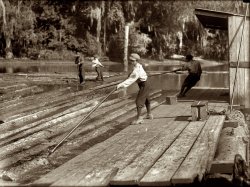
- Lena Lochiavo: 1908
- ... Sixth Street Market in front of saloon entrance." Photo by Lewis Wickes Hine. View full size.
Lena That dear child looks aged beyond ... Posted by Dave - 02/20/2019 - 1:33pm -
![Lena Lochiavo: 1908 Cincinnati, August 1908. "Lena Lochiavo, 11 years old, 209 West Sixth Street. Basket [and pretzel] seller at Sixth Street Market in front of saloon entrance." Photo by Lewis Wickes Hine. View full size.
LenaThat dear child looks aged beyond her years.
Basket GirlLena looks like she could have been a spitfire. Compared to some of the kids Hine photographed, Lena seems to have a pretty cushy job. And that's not saying a whole lot. I'd love to know her story.
Lena's LifeThis is Joe Manning, of the Lewis Hine Project. It appears from census information that Lena's last name was more like Loschiavo, and that she married Patrica Morrell, had at least seven children, and died in Cincinnati on May 20, 1974. This is not a certainty. So I have ordered Lena Morrell's obit from the Cincinnati Library. If I am able to find one of the survivors, and show that person the photo, we may know for sure. Is there anyone in Cincinnati who wants to follow up?
[Lena Morrell born April 6, 1896. - Dave]
Lena Again"Aged beyond her years" is putting it mildly! I'm in my 30s and I'd have thought she was older than me by at least a couple of years. Poor kid. It surely can't be all just from sitting there vending on the street---though as a vendor at SF cons I guess I can attest it does wear down the immune system, so maybe doing it every day would make you old...I agree with the second poster, though, I'd love to know more about her.
LoSchiavoIf it is of interest to anyone, "Lo Schiavo" means "the slave." She's probably eating better than she had in the old country and feels like she's been provided with a wonderful opportunity. I hope we find out more about her.
LenaI googled her name, and the LOC has another photo of her where she looks much much younger. Maybe not 11, but certainly not 45.
[Coming soon to a photo blog near you! - Dave]
Man to the leftWhat is he selling? Bricks? And cones of some sort?
[Cheese, maybe. Bread? Salami? - Dave]
Lena's LifeThis is Joe Manning, of the Lewis Hine Project. Lena did not turn out to be Mrs. Lena Morrell, per the obituary I obtained. So I am at a dead end. Per the 1910 census, Lena's last name is Loschiavo, and she lived with Mary, her widowed mother, and Patrina, her 16-year-old sister. Lena was born in Kentucky in 1897 or 1898. Both her parents were born in Italy. If Lena got married before 1920, then she may be listed in other records under her married name. If only I knew what it was. Is there anyone out there near Cincinnati who can look up the marriage records to see if Lena got married?
Loschiavo's of NKYI live in Covington, KY (right across the river from Cincinnati) and right up the hill from me in Park Hills is a small produce market called Loschiavo's. I'll stop by this week and tell them about this photo. Perhaps they'll have some information.
Lena's StoryI am a direct descendant of Lena's sister, Petrina Loschiavo. Lena and Petrina were the daughters of Italian farmers who immigrated to Louisville, KY and then made their way to Cincinnati. Petrina married John Mercurio, and Lena married his brother Charles. They remained in Cincinnati, where they raised their families. Lena had at least one child: a daughter, Mary, who remained close to her cousin Charles (Petrina's son), who was my grandfather. Thank you for sharing this photograph of one of my ancestors, Dave. It was a joy to find it.
(The Gallery, Cincinnati Photos, Lewis Hine, Stores & Markets)](https://www.shorpy.com/files/images/03200u1_0.thumbnail.jpg)
- Mule Spinner: 1909
- ... a dangerous place for boys." Photograph and caption by Lewis Wickes Hine. View full size.
Mule Spinner: 1909 This is Joe Manning, ... Posted by Dave - 08/06/2008 - 9:12am -
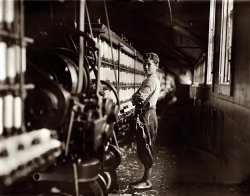
- Lane Mill: 1913
- ... in New Orleans. Violations of the law are rare." Photo by Lewis Wickes Hine. View full size.
American History Again, those young ... Posted by Dave - 11/13/2012 - 3:43pm -
![Lane Mill: 1913 November 1913. New Orleans, Louisiana. "Group of workers in Lane Cotton Mill showing the youngest workers and typical of conditions in New Orleans. Violations of the law are rare." Photo by Lewis Wickes Hine. View full size.
American HistoryAgain, those young people look like they're having a good time. Those 1913 children and teenagers seem content with their lot. Very few of their peers probably objected. Just about nobody in their "crowd" went to or graduated from high school anyway. If one's parents hadn't finished high school it was a good bet they wouldn't either. Let's us give Lewis Hine his due, he did publicize their plight. Again, I remember historian Doris Kearns Goodwin's book "No Ordinary Times," in which she wrote that less than 25 percent of WWII draftees had finished high school. When that war ended, the US Congress, in order to keep the multi-millions of servicemen out of the labor market, passed a bill then referred to as the "GI Bill of Rights." Instead of becoming a stalling mechanism it became the great equalizer. It allowed millions of returning GIs to finish high school or go to college. This created a middle class that became the envy of the world.
[The point Hine is making in this caption is that none of these kids was underage. - Dave]
I understand that. My point is that these young people didn't have a shot at continuing their education. Those few dollars that they earned were needed at home.
How young could you be?If none of these kids were underage, what was the minimum age at that time for mill work? Those boys in front seem 11-14 years old, tops.
And like most kids everywhere, they do seem to be enjoying the photo op.
[14 was the minimum age for mill work in Louisiana and several other states as of 1912. See this contemporary report. - tterrace]
14, and aging fastAround 1900, my step great grandfather was a subject in his mothers divorce. the decree stated that she would be responsible for his care until he reached the age of 14. A month after his birthday, his step father ordered him from the farm, as he was deemed "to light-weight to do farm work". Eventually he joined our family and provided shelter and sometimes food to many in our family.
Lane Cotton MillI found a local (New Orleans) history column about the Mill. It lasted almost 100 years. Not bad.
LaborLike just about everything else you could do, working in a cotton mill looks a lot more pleasant than working in a coal mine (goin' down, down, down...) They all look relatively happy and neatly dressed compared to some of the child labor seen here.
(The Gallery, Kids, Lewis Hine, New Orleans)](https://www.shorpy.com/files/images/SHORPY_02876u.thumbnail.jpg)























